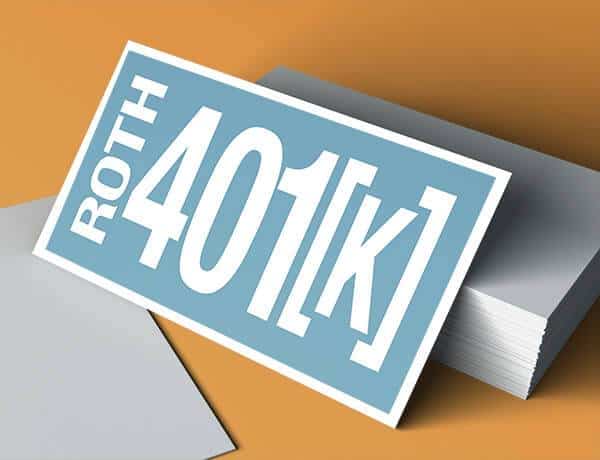Please provide your information and submit this form. Our team will be in touch with you shortly.
While many people are familiar with the benefits of traditional 401(k) plans, others are not as acquainted with Roth 401(k)s.
Since January 1, 2006, employers have been allowed to offer workers access to Roth 401(k) plans.1 And some have rolled out offerings as part of their retirement programs.
As the name implies, Roth-401(k) plans combine features of traditional 401(k) plans with those of a Roth IRA.2,3
With a Roth 401(k), contributions are made with after-tax dollars – there is no tax deduction on the front end – but qualifying withdrawals are not subject to income taxes. Any capital appreciation in the Roth 401(k) also is not subject to income taxes.
What to Choose?
The choice between a Roth 401(k) and a traditional 401(k) comes down to determining whether the upfront tax break on the traditional 401(k) is likely to outweigh the back-end benefit of tax-free withdrawals from the Roth 401(k). The information in this material is not intended as tax advice. It may not be used for the purpose of avoiding any federal tax penalties. Please consult a professional with tax or legal experience for specific information regarding your individual situation.
Often, this isn’t an “all-or-nothing” decision. Many employers allow contributions to be divided between a traditional-401(k) plan and a Roth-401(k) plan – up to overall contribution limits.
Considerations
One subtle, but key, consideration is that Roth 401(k) plans aren’t subject to income restrictions, like Roth IRAs are. This can offer advantages to high-income individuals whose Roth IRA has been limited by these restrictions. (See accompanying table.)
| Traditional 401(k) |
Roth 401(k) | Roth IRA | |
|---|---|---|---|
| Contributions | Contributions are made with pretax dollars | Contributions are made with after-tax dollars | Contributions are made with after-tax dollars |
| Income Limits | No income limits to participate | No income limits to participate | For 2019, contribution limit is phased out between $193,000 and $203,000 (married, filing jointly), and between $122,000 and $137,000 (single filers) |
| Maximum Elective Contribution* | Aggregate contributions are limited to $19,000 in 2019, ( $25,000 for those over age 50)* | Aggregate contributions are limited to $19,000 in 2019, ($25,000 for those over age 50)* | Contributions are limited to $6,000 for 2019, ($7,000 for those over age 50)* |
| Taxation of Withdrawals | Qualifying withdrawals of contributions and earnings are subject to income taxes | Qualifying withdrawals of contributions and earnings are not subject to income taxes | Qualifying withdrawals of contributions and earnings are not subject to income taxes |
| Required Distributions | In most cases, distributions must begin no later than age 72 | In most cases, distributions must begin no later than age 72 | There is no requirement to begin taking distributions while owner is alive |
|
* This is an aggregate limit by individual rather than by plan. The total of an individual’s aggregate contributions to his or her traditional and Roth 401(k) plans cannot exceed the deferral limit – $19,000 in 2019 ($25,000) for those over age 50). |
|||
Source: IRS, 2019
Roth-401(k) plans are subject to the same annual contribution limits as regular 401(k) plans – $19,000 for 2019; $25,000 for those over age 50. These are cumulative limits that apply to all accounts with a single employer; for example, an individual couldn’t save $19,000 in a traditional 401(k) and another $19,000 in a Roth 401(k).4
Another factor to consider is that employer matches are made with pretax dollars, just as they are with a traditional 401(k) plan. In a Roth 401(k), however, these matching funds accumulate in a separate account, which will be taxed as ordinary income at withdrawal.
Setting money aside for retirement is part of a sound personal financial strategy. Deciding whether to use a traditional 401(k) or a Roth 401(k) often involves reviewing a wide range of factors. If you are uncertain about what is the best choice for your situation, you should consider working with a qualified tax or financial professional.
1. To qualify for the tax-free and penalty-free withdrawal of earnings, Roth 401(k) distributions must meet a five-year holding requirement and occur after age 59½. Tax-free and penalty-free withdrawal also can be taken under certain other circumstances, such as a result of the owner’s death or disability. Employer matches are pretax and not distributed tax-free during retirement. Under the SECURE Act, generally, once you reach age 72, you must begin taking required minimum distributions.
2. Under the SECURE Act, in most circumstances, you must begin taking required minimum distributions from your 401(k) or other defined contribution plan in the year you turn 72. Withdrawals from your 401(k) or other defined contribution plans are taxed as ordinary income, and if taken before age 59½, may be subject to a 10% federal income tax penalty.
3. Roth IRA contributions cannot be made by taxpayers with high incomes. In 2019, the income phaseout limit is $137,000 for single filers, $203,000 for married, filing jointly. To qualify for the tax-free and penalty-free withdrawal of earnings, Roth IRA distributions must meet a five-year holding requirement and occur after age 59½. Tax-free and penalty-free withdrawal also can be taken under certain other circumstances, such as a result of the owner’s death or disability. The original Roth IRA owner is not required to take minimum annual withdrawals.
4. IRS.gov 2019


